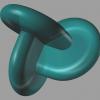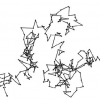Research theme: Asymptotic properties of solutions to stochastic (partial) differential equations
According to Newton's laws of motion, a lot of natural phenomena can be described by ordinary differential equations (ODEs). For such natural phenomena, if the state at some time is known, then all of the states will be determined by solving the corresponding ODE.
However, in reality, many phenomena can not be described by the Newton's laws of motion. For example, in 1828, the British botanist R. Brown (1773-1858) observed that pollen grains suspended in liquid performed an irregular motion. It is one of the typical examples and was later explained by the random collisions with the molecules of the liquid. In 1923, N. Wiener (1894-1964) idealized this motion and succeeded in introducing the stochastic process as the mathematical model to describe it.
Hence, to study the phenomena which can not be described by the deterministic approach, it is natural to consider the random fluctuations and now stochastic differential equations (SDEs) are usually adapted. SDEs, roughly speaking, are ODEs which are accompanied by some random factors varying in time. The concept of SDEs is initially introduced in K. Itô (1915-2008) in 1942, and now it has been actively applied not only in mathematics, but also in many other fields, such as physics, biology, engineering, economics.
From now on, let us explain the research subject by using the following two simple SDEs.
\begin{align} dX(t) & = -aX(t) dt + \sigma dB(t), \ X(0)=x. (1) \\ dY(t) & =b Y(t) dt + \beta Y(t) dB(t), \ Y(0)=y. (2) \end{align}
Here,$a, b, \sigma, \beta$ denote some positive constants and $B(t)$ denotes a Brownian motion.
The SDE (1) is called the Langevin equation, which is used to describe the motion of a particle with friction. By Itô's formula, one can easily show that the solution of (1) is
$$ X(t)=\exp\{-at\}x+ \int_0^t \exp\{-a(t-s)\}\sigma dB(s), \ t\geq 0 $$
and it is called the Ornstein-Uhlenbeck process.
The SDE (2) is very famous as the mathematical models for the population change and the stock price fluctuation. Its solution is
$$ Y(t)=y \exp \{(b-\frac12 \beta^2)t + \beta B(t) \}, \ t\geq 0, $$
which is called geometric Brownian motions. We assume $y >0$ in the following.
Now let us consider the asymptotic behavior of the solutions to (1) and (2). Letting $t\to \infty$,the following properties are well known.
(i) The law of $X(t)$ converges weakly to the Normal distribution with mean $0$ and variance $\frac{\sigma^2}{2a}$.
(ii) $\bullet$ If $b>\frac{ \beta^2}2$, then $Y(t)$ diverges to $+\infty$ a.s.
$\bullet$ If $b=\frac{ \beta^2}2$, then $Y(t)$ fluctuates inside $(0, \infty)$ a.s
$\bullet$ If $b<\frac{ \beta^2}2$, then $Y(t)$ converges to $0$ a.s.
From the above results,although these two equations look similar, it is clear that the asymptotic behaviors of the SDEs (1) are (2) very different. As we saw in (i),the behavior that the law of $X(t)$ converges weakly to a probability distribution independent of its initial law is call the ergodic property. And as that in (ii),the SDEs have various behaviors depending on their coefficients, which are relative to the stability of systems.
From the above examples, we know that it is very important and interesting to study the asymptotic behavior of the solutions to SDEs and stochastic partial differential equations (stated below).
Research Area: Stochastic partial differential equations
I mainly study the stochastic partial differential equations (SPDEs) by using the theory of probability and in particular the stochastic analysis. Briefly speaking, SPDEs are partial differential equations with some random fluctuations in both time variables and spatial variables. As we have stated, to understand actual phenomena, exterior influences and (or) observation errors should be considered. Hence, SPDEs are usually used as the mathematical models to describe the random development of phenomena depending on time and space. In fact, SPDEs have appeared in many fields from physics to biology, engineering and economics.
For different phenomena, many SPDEs have been introduced, such as stochastic wave equations for the string vibration and acoustic wave propagation, stochastic Burgers equations and stochastic Navier-Stokes equations for fluid motion, stochastic Ginzburg-Landau equations for superconductivity, Kardar-Parisi-Zhang equations for the growth of interface with random fluctuation.
I mainly investigate the following SPDEs:
\begin{align} \frac{\partial u}{\partial t}(t, x)&= -(-\Delta)^{\frac{\alpha}{2}} u(t, x) + b(u(t,x))\notag \\ & \qquad + \sigma(u(t,x)) \dot{W}(t,x), (3) \end{align}
where $\alpha\in (1, 2]$, $\Delta$ is the Laplacian,$b$ and $\sigma$ are called the external force term and respectively the diffusive coefficient, $\dot{W}(t,x)$ denotes the space-time white noise.It is obvious that (3) includes stochastic heat equations and stochastic Allen-Cahn equations describing the phase separation in alloy as its important examples. It is vital and interesting to know what the solution is like after a long time. I mainly do some researches on the ergodic property, stability and intermittent property of (3).
I am also interested in high order SPDEs, such as the stochastic Cahn-Hilliard equation
\begin{align*} \frac{\partial u}{\partial t}(t, x)&= -\Delta \big(\Delta u(t, x)+ b(u(t,x)) \big) \\ &\qquad + \sigma(u(t,x))\dot{W}(t,x) \notag \end{align*}
and the stochastic Cahn-Hilliard equation with reflection
\begin{align} \frac{\partial u}{\partial t}(t, x)&= -\Delta \big(\Delta u(t, x)+ b(u(t,x)) +\dot{\eta}(t,x) \big) \notag \\ &\qquad + \frac{\partial}{\partial x}\dot{W}(t,x). (4) \end{align}
Here, $\eta$ in (4) is a positive random measure, which is determined by $b$ and the value of $u(t,x)$. These kinds of SPDEs, similarly as the stochastic Allen-Cahn equation, are important mathematical models for the phase separation in alloy. In particular, the SPDE (4) are now regarded as the infinite dimensional Skorokhod equation and can be deduced from the fluctuation of conservative interface model on a hard wall. In the future, I will also devote to studying the asymptotic properties of the above SPDEs.



